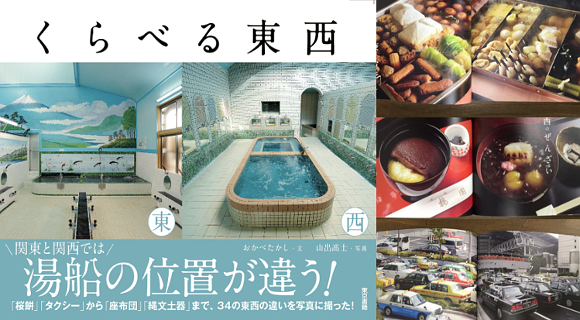
Kuraberu Tōzai presents an easy-to-understand compilation of regional differences between Tokyo and Osaka in terms of cuisines, art, and cultural traditions.
With visitors to Japan often making the journey between Tokyo, located in the eastern Kanto region, and Osaka and Kyoto, located in the western Kansai region of the country, many people will have noticed the cultural differences that exist between two of the nation’s most populous areas. When riding on the escalator in the Kanto region, (Tokyo, Chiba, Saitama, Gunma, Tochigi, Ibaraki, and Kanagawa), it’s customary to stand on the left, while in Kansai (Osaka, Kyoto, Nara, Mie, Wakayama, Hyōgo, and Shiga), people are said to stand on the right. There are interesting differences in the language too, with the Kansai-ben regional dialect replacing “arigato” with “ookini” for “thank you“.
People in Japan and around the world are continually fascinated by the intriguing distinctions between the two areas, and now there’s a new book on the scene dedicated to addressing the subject through a series of easy-to-understand images.
▼ Called “Kuraberu Tōzai”, or “East and West Compared”, the cover of the book instantly draws readers into the subject with the image of a public bath placed by the wall in the eastern region of Japan (left) and in the centre of the room in the west (right).
「くらべる東西」のカバーをツイートしたところ銭湯愛好家の方からたくさんリツイートしていただき、世の銭湯ファンの多さを改めて感じているところですが、この両銭湯の名前、この写真だけでおわかりになる方けっこうおられるのかしらん。 pic.twitter.com/rdcK26xS5Z
— 岡部敬史(おかべたかし) (@okataco) June 6, 2016
Inside, there are a number of beautiful side-by-side images showing the distinctions between east (東) and west (西) Japan.
There are colourful taxi cabs on the roads of Kanto, compared to sleek, dark taxi cabs in Kansai.
ずっとこんな本が出てほしいと思っていた。東西の違いを、ビジュアルとテキストで比べる。一目瞭然。特に食べ物問題は切実で、私(関西人)は東京で出された「ぜんざい」にびっくりしたのを思い出しました。おかべたかし『くらべる東西』(東京書籍) pic.twitter.com/v6XoVl8xbe
— Title(タイトル) (@Title_books) June 13, 2016
The difference between the slicing of negi leeks used in cooking is even addressed.
[仕入速報]写真集『くらべる東西』(東京書籍)が大人気です。西と東の文化の違いが一目でわかる! 思わず唸ってしまう解説文もおもしろい。個人的には居酒屋でよく出る「白・青ねぎ」の背景が勉強になりました。1F,2F,7Fまで。Y.O. pic.twitter.com/alypajCgvM
— 紀伊國屋書店 新宿本店 (@KinoShinjuku) June 15, 2016
The warm sweet red bean paste dessert known as zensai are also served differently according to the region.
ずっとこんな本が出てほしいと思っていた。東西の違いを、ビジュアルとテキストで比べる。一目瞭然。特に食べ物問題は切実で、私(関西人)は東京で出された「ぜんざい」にびっくりしたのを思い出しました。おかべたかし『くらべる東西』(東京書籍) pic.twitter.com/v6XoVl8xbe
— Title(タイトル) (@Title_books) June 13, 2016
▼ There are differences between the country’s shichimi seven-spice mixture…
今週発売の「くらべる東西」から「東西あるある」ネタをツイートするコーナー。今朝は「七味唐辛子」です。ご覧のように東のほうが赤い唐辛子が目立ち、西は黒い山椒が目立つ。関西は大抵山椒が強い七味を揃えてますね。食卓の二つ揃えると楽しいよ pic.twitter.com/0r6EWXyQ5C
— 岡部敬史(おかべたかし) (@okataco) June 5, 2016
▼ And also intriguing distinctions between ancient pottery traditions.
もうすぐ発売「くらべる東西」から東西の違いを紹介するコーナー。今朝は「縄文土器」です。ご覧のように東のほうが派手なのは、縄文時代は関東のほうが豊かで社会も発展していたから。東の豊かさは鮭やドングリに支えられていたという説があります。 pic.twitter.com/9WVsEhJ9xY
— 岡部敬史(おかべたかし) (@okataco) June 7, 2016
Even the little parcels of inarizushi soy-wrapped rice morsels are packed differently in the Kanto and Kansai areas.
▼ Oden hot pot styles and ingredients also differ.
The book also asks readers to spot the difference between zabuton cushion seats in each region.
All these interesting comparisons and distinctions have been inspiring Twitter users to think of their own ideas, like this one that compares the differences between the cold noodle dish known as Hiyashi Chuka.
https://twitter.com/sea_haya/status/742228556449599488The book is currently available on Amazon Japan and at bookstores around the country, and with the popularity of the book soaring online through social media, it won’t be long before it makes its way to cafes and hotel lobbies from east to west for tourists and visitors to flick through.
Source: Togetter
Top Image: Twitter/@shohei_ (edited by RocketNews24)
Insert Images: Hatena Blog/okataco

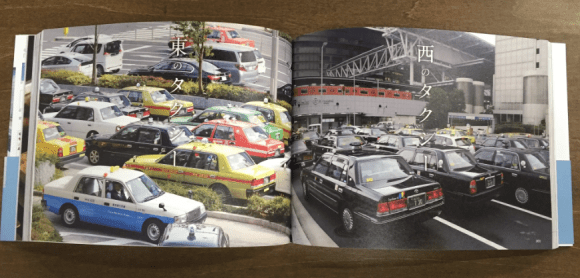
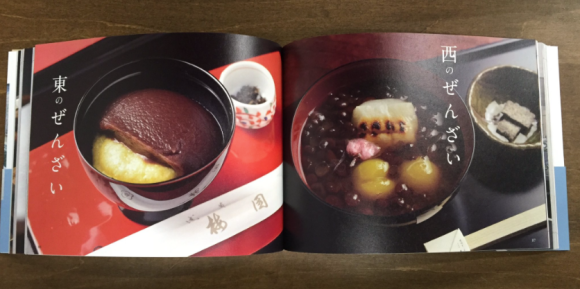
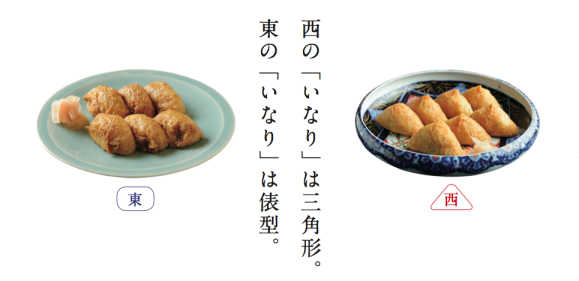
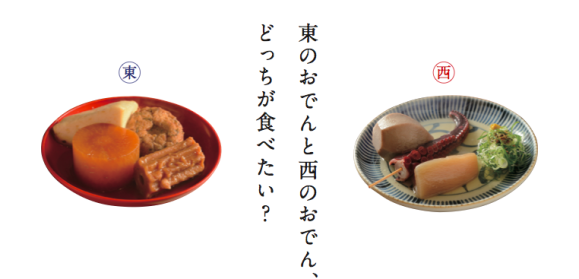
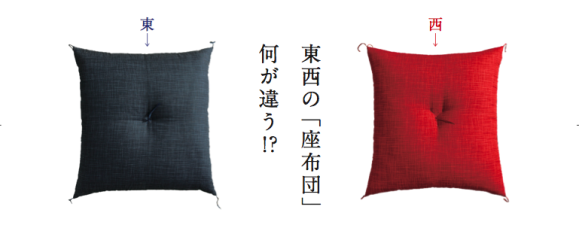
 Iketara iku: A simple Japanese phrase that people in Tokyo and Osaka take completely differently
Iketara iku: A simple Japanese phrase that people in Tokyo and Osaka take completely differently Osaka earthquake: Scenes show damage from strongest tremor to hit the region in decades
Osaka earthquake: Scenes show damage from strongest tremor to hit the region in decades Kansai and Kanto prove again that they are each distinct regions when it comes to food
Kansai and Kanto prove again that they are each distinct regions when it comes to food This type of conveyor belt sushi tastes different in Tokyo than it does in Osaka, but why?
This type of conveyor belt sushi tastes different in Tokyo than it does in Osaka, but why? Pork or beef? A peek into how Japan’s curry preferences change from place to place
Pork or beef? A peek into how Japan’s curry preferences change from place to place McDonald’s new Happy Meals offer up cute and practical Sanrio lifestyle goods
McDonald’s new Happy Meals offer up cute and practical Sanrio lifestyle goods Studio Ghibli releases new action figures featuring Nausicaä of the Valley of the Wind characters
Studio Ghibli releases new action figures featuring Nausicaä of the Valley of the Wind characters Studio Ghibli glasses cases let anime characters keep an eye on your spectacles
Studio Ghibli glasses cases let anime characters keep an eye on your spectacles All-you-can-drink Starbucks and amazing views part of Tokyo’s new 170 meter-high sky lounge
All-you-can-drink Starbucks and amazing views part of Tokyo’s new 170 meter-high sky lounge Super Nintendo World expansion gets delayed for several months at Universal Studios Japan
Super Nintendo World expansion gets delayed for several months at Universal Studios Japan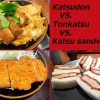 Katsudon vs. tonkatsu vs. katsu sandwich – What’s the best way to eat pork cutlet in Japan?
Katsudon vs. tonkatsu vs. katsu sandwich – What’s the best way to eat pork cutlet in Japan? Kyoto’s 100 Demons yokai monster parade returns!
Kyoto’s 100 Demons yokai monster parade returns! More foreign tourists than ever before in history visited Japan last month
More foreign tourists than ever before in history visited Japan last month The 2023 Sanrio character popularity ranking results revealed
The 2023 Sanrio character popularity ranking results revealed The oldest tunnel in Japan is believed to be haunted, and strange things happen when we go there
The oldest tunnel in Japan is believed to be haunted, and strange things happen when we go there Disney princesses get official manga makeovers for Manga Princess Cafe opening in Tokyo
Disney princesses get official manga makeovers for Manga Princess Cafe opening in Tokyo Starbucks reopens at Shibuya Scramble Crossing with new look and design concept
Starbucks reopens at Shibuya Scramble Crossing with new look and design concept Beautiful new Final Fantasy T-shirt collection on the way from Uniqlo【Photos】
Beautiful new Final Fantasy T-shirt collection on the way from Uniqlo【Photos】 Is the new Shinkansen Train Desk ticket worth it?
Is the new Shinkansen Train Desk ticket worth it? Foreign English teachers in Japan pick their favorite Japanese-language phrases【Survey】
Foreign English teachers in Japan pick their favorite Japanese-language phrases【Survey】 Beautiful Sailor Moon manhole cover coasters being given out for free by Tokyo tourist center
Beautiful Sailor Moon manhole cover coasters being given out for free by Tokyo tourist center Studio Ghibli releases Kiki’s Delivery Service chocolate cake pouches in Japan
Studio Ghibli releases Kiki’s Delivery Service chocolate cake pouches in Japan Japan’s bone-breaking and record-breaking roller coaster is permanently shutting down
Japan’s bone-breaking and record-breaking roller coaster is permanently shutting down New definition of “Japanese whiskey” goes into effect to prevent fakes from fooling overseas buyers
New definition of “Japanese whiskey” goes into effect to prevent fakes from fooling overseas buyers Our Japanese reporter visits Costco in the U.S., finds super American and very Japanese things
Our Japanese reporter visits Costco in the U.S., finds super American and very Japanese things Studio Ghibli unveils Mother’s Day gift set that captures the love in My Neighbour Totoro
Studio Ghibli unveils Mother’s Day gift set that captures the love in My Neighbour Totoro Domino’s Japan now sells…pizza ears?
Domino’s Japan now sells…pizza ears? New Japanese KitKat flavour stars Sanrio characters, including Hello Kitty
New Japanese KitKat flavour stars Sanrio characters, including Hello Kitty One of Tokyo’s most famous meeting-spot landmarks is closing for good
One of Tokyo’s most famous meeting-spot landmarks is closing for good Kyoto creates new for-tourist buses to address overtourism with higher prices, faster rides
Kyoto creates new for-tourist buses to address overtourism with higher prices, faster rides Sales of Japan’s most convenient train ticket/shopping payment cards suspended indefinitely
Sales of Japan’s most convenient train ticket/shopping payment cards suspended indefinitely Sold-out Studio Ghibli desktop humidifiers are back so Totoro can help you through the dry season
Sold-out Studio Ghibli desktop humidifiers are back so Totoro can help you through the dry season Japanese government to make first change to romanization spelling rules since the 1950s
Japanese government to make first change to romanization spelling rules since the 1950s Ghibli founders Toshio Suzuki and Hayao Miyazaki contribute to Japanese whisky Totoro label design
Ghibli founders Toshio Suzuki and Hayao Miyazaki contribute to Japanese whisky Totoro label design Doraemon found buried at sea as scene from 1993 anime becomes real life【Photos】
Doraemon found buried at sea as scene from 1993 anime becomes real life【Photos】 Tokyo’s most famous Starbucks is closed
Tokyo’s most famous Starbucks is closed One Piece characters’ nationalities revealed, but fans have mixed opinions
One Piece characters’ nationalities revealed, but fans have mixed opinions We asked a Uniqlo employee what four things we should buy and their suggestions didn’t disappoint
We asked a Uniqlo employee what four things we should buy and their suggestions didn’t disappoint Princesses, fruits, and blacksmiths: Study reveals the 30 most unusual family names in Japan
Princesses, fruits, and blacksmiths: Study reveals the 30 most unusual family names in Japan New Pokémon Line app message stamps raise money for children in Japan’s disaster-struck regions
New Pokémon Line app message stamps raise money for children in Japan’s disaster-struck regions People in Japan capture images of fireball plummeting towards earth in night sky【Video】
People in Japan capture images of fireball plummeting towards earth in night sky【Video】 The surprisingly deep differences of sailor suit school uniform collar styes – Kanto-eri and more
The surprisingly deep differences of sailor suit school uniform collar styes – Kanto-eri and more Japan’s favorite Pokémon types by prefecture–which types are the most popular?
Japan’s favorite Pokémon types by prefecture–which types are the most popular? Kyoto book cafe serves up cute cat parfaits in traditional Japanese machiya townhouse
Kyoto book cafe serves up cute cat parfaits in traditional Japanese machiya townhouse New Japan rail pass gives you a week of free rides in a huge space to chase the cherry blossoms
New Japan rail pass gives you a week of free rides in a huge space to chase the cherry blossoms Japan’s new manhole cover T-shirts let you show off your local prefectural pride
Japan’s new manhole cover T-shirts let you show off your local prefectural pride Why do seats at some Japanese station platforms face away from the trains?
Why do seats at some Japanese station platforms face away from the trains? Don’t know which sake to drink? These handy flavor charts help you pick by region of Japan
Don’t know which sake to drink? These handy flavor charts help you pick by region of Japan Coca-Cola’s new limited-edition Japan travel destination bottles highlight history and culture
Coca-Cola’s new limited-edition Japan travel destination bottles highlight history and culture Travel tip! Japan Railways to offer awesome new three-day unlimited pass for Tokyo and east Japan
Travel tip! Japan Railways to offer awesome new three-day unlimited pass for Tokyo and east Japan “Amazing Kyoto” shows us sides of Japan’s old capital we’ve never seen before — in two languages!
“Amazing Kyoto” shows us sides of Japan’s old capital we’ve never seen before — in two languages! Takoyaki…inarizushi? New fusion food boggles the mind in Japan
Takoyaki…inarizushi? New fusion food boggles the mind in Japan Tokyo taxi company to release smartphone app with battling princesses
Tokyo taxi company to release smartphone app with battling princesses Kyoto temple grants love wishes to visitors who discover their heart-shaped hydrangeas
Kyoto temple grants love wishes to visitors who discover their heart-shaped hydrangeas Japanese prefectural governor wants foreign tourists to pay special extra fee
Japanese prefectural governor wants foreign tourists to pay special extra fee
Leave a Reply